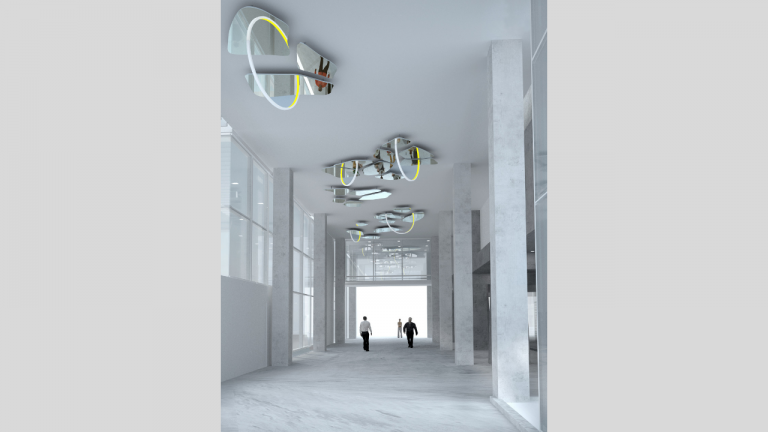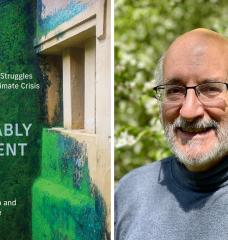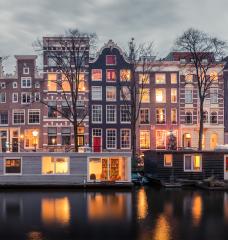
Olafur Eliasson is an Icelandic-Danish visual artist based in Copenhagen and Berlin. He works across many media, including sculpture, painting, installation, photography, and film. Some notable exhibitions include The Weather Project at the Tate Modern, and The New York City Waterfalls.
Most recently, he was commissioned under the MIT List Visual Arts Center’s Percent-for-Art Program to implement a public artwork on the MIT campus. His piece, Northwest Passage, is located in the foyer of Building 12 at MIT. Drawing inspiration from the depleting ice sheets in the Parry Channel of the Northwest Passage, this work highlights climate change’s impacts on the arctic, and society at large. We sat down with Olafur to discuss his artwork and its incorporation of a climate change narrative.
Mikaela: What inspired you to make art that deals with climate change, and other environmental themes?
Olafur: In talking about the Anthropocene, Bruno Latour has commented that there is no outside. My generation is perhaps the last generation that can take nature for granted as something outside us, as something separate from culture. I remember when I was a child, I visited my grandparents in Iceland in the seventies, during the energy crisis, and there was a city-wide blackout every evening to conserve energy. When the lights would go out, I remember sitting indoors, and the lighting outside would change radically. It suddenly became stronger, and you could see that it was in fact still light outside, it was dusk (this was in the Icelandic summer when the days are intensely long).

For me, this was a very formative experience in my thinking about light, and it has affected my art practice. It would take me years to understand the geopolitical significance of this phenomenological experience, and in fact, it was only after The weather project at Tate Modern in 2003, that I began thinking explicitly about climate change and how it affects everything.
Mikaela: How did you initially get involved at MIT, and begin Northwest Passage?
Olafur: The project began around the time of my visit to MIT for the McDermott award. It was very inspirational for me to see the culture there, the incredible creativity and energy and possibilities at the school. And it was also interesting to visit the main building which mirrored the energy of the students, with its Infinite Corridor and the sense of how one thing had been added to another to create an immense architectural collage.
Mikaela: How would you describe Northwest Passage from a formalist standpoint?
Olafur: The work was conceived for the specific context of the entrance corridor and passageway of the MIT.nano building. Formally it is itself a kind of passageway that leads people in the space along from one abstract mirror island to the next. The semicircular lights, which are turned into full rings by the mirrors, guide the viewers along as they catch inverted glimpses of themselves in the mirrors above.

Mikaela: How would you describe Northwest Passage from a conceptual standpoint?
Olafur: The mirrors are cut according to the outlines of the fragments of free-floating ice in the Parry Channel of the Northwest Passage, the route through the Arctic ocean that links the Pacific and the Atlantic. It was long sought after, motivating much European exploration of the northern regions of North America, and until now it was impassable without an icebreaker. As a model for the work, I took the pattern of ice floes that formed in 2007, when the melt was so extreme that vessels could pass through it without an icebreaker. In that sense, it is a sign of things to come.
Mikaela: How can we inspire and empower people to take action against climate change through art?
Olafur: I think what we see is that many people know that something needs to be done, and many even know what needs to be done, and yet we do not do the right thing. My friend Elke Weber, who is an expert on these questions, explained to me that the brain consists of two systems, an experiential and an analytic system, and that although there is evidence that people are much more convinced by experience than by data, scientists believe they can convince people through data. I believe art can help here.
This is why I have made works like Ice Watch, where I brought large blocks of ice from Greenland to public squares in Copenhagen and Paris. The tactile experience of touching this ice that is melting, that has broken off from the Greenland ice sheet as a result of global warming, is so powerful that it reaches people in a way that reading about climate change cannot do.
We often think of the two as opposed, that art is somehow passive where activism is not. But I think that art is very active, that it is involved every day with touching people and moving them to take action in the world. Art is about changing minds and moving worlds.






